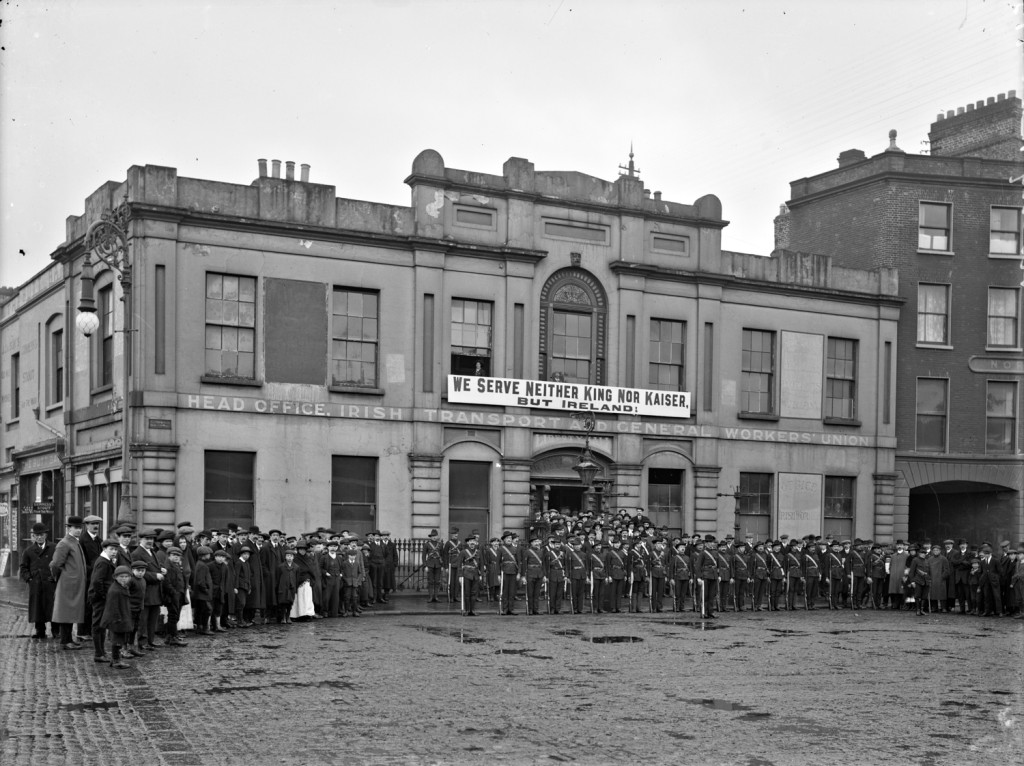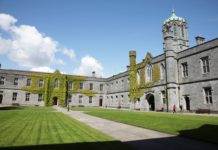There is a lesser-known story of how Jim Larkin and the ITGWU organised North Dublin’s farm labourers and how Baldoyle became the only Irish Citizen Army brigade outside Dublin City from the Lockout to the Easter Rising, writes David Worth.
The Irish Citizen Army was born amidst the struggle which erupted between workers and employers during the Dublin Lockout. That conflict lasted from August 1913 to January 1914. This militant armed wing of the Irish Transport and General Workers Union never numbered more than a thousand men and women in its ranks but its existence as the first workers’ army in Europe would have a defining impact on Irish working class history.
In 1913 locked out workers from the Jacob’s biscuit factory on Aungier Street who were members of the ITGWU and numbering in their hundreds marched down South Great George’s Street.
They were led by the Fintan Lalor pipe band whose music greatly helped the morale of the striking workers. Founded in 1912 this band – named for the radical Young Irelander James Fintan Lalor – would go on to become known as the band of the Irish Citizen Army (ICA) and they would play a crucial role in the founding of the ICA.
While marching to a meeting which was to be addressed by James Connolly and James Larkin they were attacked by members of the Dublin Metropolitan Police. At the moment they had been performing ‘The Peeler and the Goat’, a well known musical insult to police.
The band members were defended by ITGWU members armed with hurls and sticks. They eventually beat back the police. These agitants would form the nucleus of the ICA when it was founded the next year.
The worst violence the locked out workers experienced at the hands of the police occurred on Sunday 31st August 1913. James Larkin, who was on the run, was due to address the large crowd which had gathered. Before he could speak the Dublin Metropolitan Police (DMP) baton charged the crowd killing two men. This day was to become known as the first Bloody Sunday.
Even before the lockout, the DMP had a reputation for violence. But the violence they showed the locked out and starving workers was particularly fearsome. As one striker remarked about the Dublin Metropolitan Police: ‘it was never necessary to tell them to use batons’. As a matter of fact, the more they used their batons and fists the more appreciation they got from Dublin Castle.
During the lockout there also existed an army of armed scabs and shootings were commonplace.
A workers selfdefence force
James Larkin, the leader of the ITGWU, was convinced of the need for a workers selfdefense force in order to defend striking workers from savage police brutality.
Jack White, a former soldier in the British Army, was decorated for his service during the Boer War and was the son of a field Marshall. He was also a committed socialist who offered to organise and discipline this new fighting force.
Although the ICA was never involved in any major conflict during the lockout, as Jack White noted, the existence and appearance of the ICA ‘put manners on the police’.
The ICA would see some action two years later during Easter Week of 1916. About 250 members of the ICA would participate. During the Easter Rising the members of the ICA fought under their banner the Starry Plough. The original starry plough was a green flag with a golden plough and a depiction of the constellation Ursa Major.
There are many interpretations of this flag and its origins. The flag was designed to appeal to the Irish working class, which at the time, was largely composed of farm labourers living in rural areas. Although most of the members of the Irish Citizen Army were members of the urban working class, they still made efforts to organise in more rural areas such as Baldoyle.
Organising farm labourers
In 1913 an ITGWU campaign to organise farm workers in these rural areas aimed for improved pay and conditions. Larkin sought the recognition of the ITGWU by independent farmers and large estate owners. This would bring him into conflict with the County Dublin’s Farmers’ Association, the body that represented these wealthy farmers.
The conditions in which these farm labourers had lived in had steadily grown worse in the years before the lockout. The landowners of north county Dublin had switched from tillage to pastoral farming, thereby creating far more profits for them but little for their workers who continued to live in dire conditions on low pay.
Larkin capitalised on these grievances and the farm labourers responded to his fiery brand of trade unionism. One contemporaneous newspaper described north Dublin as the ‘principal rallying ground for the Larkinites’.
Because farm labourers only made up about 20 percent of the country’s population, Larkin recognised that without linking their struggle with that of the labourers living in towns that their efforts would fail. Larkin actively encouraged city workers to meet with rural workers to promote the benefits of trade union organising.
He used the Irish Worker, the newspaper of the ITGWU, to spread this message. These meetings encouraged the farm labourers of north Dublin and were in keeping with a dictum often associated with Larkin, that an injury to one was an injury to all. Larkin’s first recruiting meeting of farm workers would take place in Baldoyle on Sunday 8th June 1913. He hoped to recruit them into the ITGWU so that they could fight for improved conditions.
But Larkin had another motive for organising farm labourers. He hoped that by improving the lot of farm labourers, they would be less inclined to migrate to the cities where they would compete with urban labourers for available jobs and cause further overcrowding in Dublin’s appalling tenements.
For farm labourers who had been ignored for decades by nationalist politicians, Larkin’s message had an obvious appeal. For the first time someone had offered to fight their cause without any preconditions. Branches of the ITGWU would soon be established in Swords, Balbriggan, Lucan and Santry.
Farm labourers on strike
They would make their first demands in August 1913, at the height of the harvest season, thereby giving the union an upper hand in negotiating for improved pay. The farmers refused to meet with the union and their workers. This hard line stance led to a number of walkouts on Larkin’s orders. Large numbers of farm labourers were soon on strike.
The summer of 1913 saw excellent conditions for farming but with their workforce on strike, the farmers were cognisant of the possibility of wasting that year’s harvest. They quickly gave in to the union’s demands and agreed to increase the farm labourers’ wages.
This wage agreement represented a victory for Larkin and the ITGWU. It underlined the influence which the union now had over previously unorganised workers. The success of the farm labourers would go a long way towards establishing the ITGWU as one big union to represent all the interests of unskilled workers in the country.
Soon this agreement would unravel as William Martin Murphy, the press baron and politician who was nicknamed “William Murder Murphy” during the lockout, pushed the farmers of north Dublin to adopt the same stance as the employers in the city.
So on 12th September 1913, the Farmers Association agreed not to employ any members of the ITGWU. For a second time, the labourers of north Dublin downed tools and went on strike. All efforts to reach a settlement failed and the battle lines were now drawn.
The Lockout
North Dublin would be greatly affected by the lockout. It would see regular demonstrations by striking workers that often descended into violence. On one occasion, the police shot a young worker dead in Finglas as he protested outside of a pub which was serving scabs. The DMP on that occasion had to be rescued by a convoy of heavily armed RIC men.
The strength the striking workers had initially shown would eventually diminish as the employers refused to back down. The strikers’ position was greatly undercut by the importation of workers from outside their own areas who were willing to work for the wages offered by the farmers. These scab labourers were often targeted by strikers.
Disgruntled strikers were known to burn harvested goods that had been collected by non union workers. One farmer in November 1913 lost 50 tons of hay through arson. Faced with the prospect of a long and hungry winter, it was no wonder that the strikers resorted to these tactics to break the farmers’ resolve.
This was not, alas, enough, as Christmas of 1913 proved to be a particularly hard and cold one for strikers and their families. Larkin, despite his desire to continue the strike, found it impossible to stop desperate strikers from returning to work.
What began as a dispute about wages would eventually transform into a battle for recognition of the workers’ membership of the ITGWU. The labourers of the city and the farm labourers of north county Dublin would fight against their employers in a brutal struggle that lasted for months.
The workers would remember the long hard months of the lockout, and in 1916 men and women from Baldoyle would fight in the Irish Citizen Army. Theirs was the only company that existed outside the city of Dublin, from the period of the lockout until the Easter rising.
James McCormack, who was a founder of the ITGWU branch in Baldoyle, was killed on Wednesday of Easter Week. He had led men and women from the area as they marched from Liberty Hall to occupy the GPO in the great rebellion that would mark the beginning of a new fight for Irish independence.





